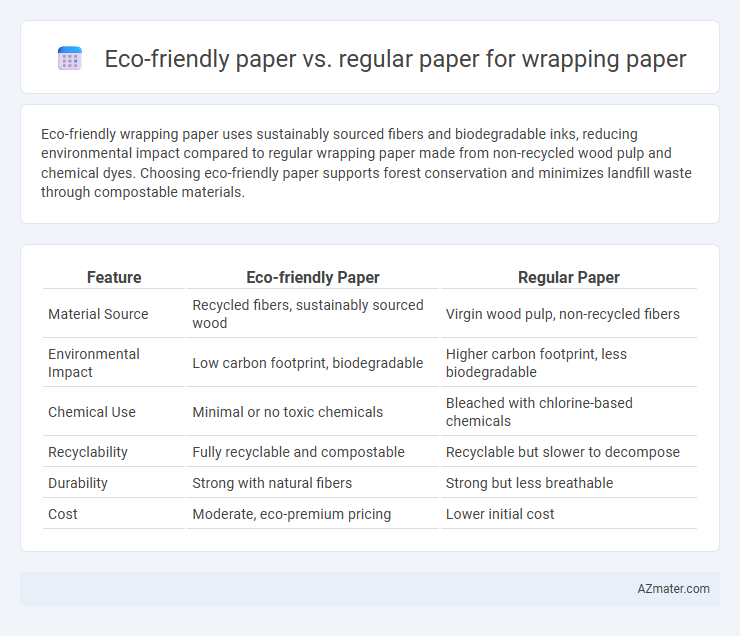Eco-friendly wrapping paper uses sustainably sourced fibers and biodegradable inks, reducing environmental impact compared to regular wrapping paper made from non-recycled wood pulp and chemical dyes. Choosing eco-friendly paper supports forest conservation and minimizes landfill waste through compostable materials.
Table of Comparison
| Feature | Eco-friendly Paper | Regular Paper |
|---|---|---|
| Material Source | Recycled fibers, sustainably sourced wood | Virgin wood pulp, non-recycled fibers |
| Environmental Impact | Low carbon footprint, biodegradable | Higher carbon footprint, less biodegradable |
| Chemical Use | Minimal or no toxic chemicals | Bleached with chlorine-based chemicals |
| Recyclability | Fully recyclable and compostable | Recyclable but slower to decompose |
| Durability | Strong with natural fibers | Strong but less breathable |
| Cost | Moderate, eco-premium pricing | Lower initial cost |
Introduction to Wrapping Paper Choices
Eco-friendly wrapping paper is made from recycled materials or sustainably sourced fibers, reducing environmental impact and minimizing waste in gift packaging. Regular wrapping paper often contains non-recyclable elements like metallic finishes, plastics, or dyes, making it less biodegradable and harder to recycle. Choosing eco-friendly wrapping paper supports sustainable practices and promotes responsible consumption in gift-giving occasions.
What Makes Paper Eco-Friendly?
Eco-friendly wrapping paper is made from recycled materials, biodegradable fibers, and non-toxic dyes, reducing environmental impact and conserving natural resources. It often includes certifications like FSC or SFI, ensuring responsible forest management and sustainable production practices. In contrast, regular wrapping paper typically contains bleached pulp, plastic coatings, and harmful chemicals that hinder recyclability and contribute to landfill waste.
Regular Wrapping Paper: Composition and Impact
Regular wrapping paper is typically made from virgin wood pulp, containing non-recycled fibers and often coated with plastic films, dyes, or glitter to enhance visual appeal. This composition results in limited biodegradability and challenges in recycling, contributing to increased landfill waste and environmental pollution. The production process also consumes significant energy and water resources, leading to a higher carbon footprint compared to eco-friendly alternatives.
Environmental Benefits of Eco-Friendly Wrapping Paper
Eco-friendly wrapping paper significantly reduces deforestation and waste by using recycled materials and sustainable fibers, lowering its carbon footprint compared to regular paper. It minimizes chemical pollution as it often avoids toxic dyes and bleaches found in conventional wrapping papers. Choosing eco-friendly options supports a circular economy and helps conserve natural resources, promoting long-term environmental health.
Comparing Production Processes
Eco-friendly wrapping paper is produced using recycled materials and sustainable fibers, minimizing the use of water, energy, and harmful chemicals compared to regular paper, which typically relies on virgin wood pulp and intensive bleaching processes. The production of eco-friendly paper incorporates chlorine-free bleaching and eco-conscious ink, significantly reducing environmental pollutants and carbon emissions. In contrast, regular paper manufacturing often involves high energy consumption and chemical treatments that contribute to deforestation and increased pollution levels.
Biodegradability and Recyclability
Eco-friendly wrapping paper is designed for superior biodegradability, breaking down naturally without releasing harmful chemicals into the environment. It typically contains recycled fibers and avoids plastic coatings, making it easier to recycle compared to regular wrapping paper that often includes non-recyclable glitter, foil, or plastic lamination. Choosing eco-friendly paper supports sustainable waste management by promoting efficient recycling and reducing landfill impact.
Cost Analysis: Eco-Friendly vs Regular Paper
Eco-friendly wrapping paper often carries a higher upfront cost compared to regular paper due to sustainable sourcing and environmentally responsible manufacturing processes, yet it can lead to long-term savings by reducing waste disposal fees and supporting circular economies. Regular wrapping paper tends to be cheaper initially, but it frequently contains non-recyclable materials, resulting in increased environmental disposal costs and potential regulatory penalties. Evaluating cost analysis requires factoring in true expenses, including raw material sustainability, production emissions, recyclability, and end-of-life environmental impact.
Aesthetic Differences and Customization
Eco-friendly wrapping paper often features natural textures, muted tones, and subtle patterns that appeal to consumers seeking a rustic or minimalist aesthetic, contrasting sharply with the vibrant colors and glossy finishes typical of regular wrapping paper. Customization options in eco-friendly paper emphasize sustainable inks and materials, allowing for personalized designs that maintain environmental integrity without compromising visual appeal. While regular wrapping paper supports high-resolution prints and intricate designs, eco-friendly alternatives balance aesthetic charm with eco-conscious choices, offering unique customization tied to sustainability.
Consumer Trends and Preferences
Consumer trends increasingly favor eco-friendly wrapping paper due to rising environmental awareness and demand for sustainable products. Eco-friendly paper typically uses recycled materials and biodegradable inks, appealing to zero-waste advocates and environmentally conscious shoppers. In contrast, regular wrapping paper, often coated with plastic or metallic finishes, faces declining preference due to difficulties in recycling and environmental impact concerns.
Making the Sustainable Choice
Eco-friendly wrapping paper is made from recycled materials or sustainably sourced fibers, reducing deforestation and pollution compared to regular paper. It often contains fewer harmful chemicals and uses eco-conscious dyes, minimizing environmental impact during production and disposal. Choosing eco-friendly paper supports sustainable forestry, decreases landfill waste, and promotes a circular economy in the gift packaging industry.

Infographic: Eco-friendly paper vs Regular paper for Wrapping paper
 azmater.com
azmater.com